Mechanism of Combustion Noise Influenced by Pilot Injection in PPCI Diesel Engines
Abstract
:1. Introduction
2. Experimental Setup
3. Results and Discussion
3.1. Analysis of In-Cylinder Pressure and Heat Release Rate
3.2. Combustion Noise Analysis by Cylinder Pressure Levels
3.3. SWT of In-Cylinder Pressure Signals
3.4. SWPT of In-Cylinder Pressure Signals
4. Conclusions
- (1)
- Generally, main injection is the significant factor that affects combustion noise in low and mid frequency segments, and an increase of the pilot mass results in mitigation of combustion noise. Pilot injection plays an essential role in high frequency combustion noise, and larger pilot injection quantities lead to higher combustion noise in the high-frequency domain.
- (2)
- Advancing pilot injection timing will attenuate pilot combustion noise energy in mid and high frequency domains, but will strengthen that in the low-frequency range. Additionally, an earlier pilot injection timing also leads to higher main combustion noise energy in almost the whole frequency spectrum.
- (3)
- From the results of SWPT, pilot and main injection combustion impacts on high-frequency combustion noise are concentrated in the frequency band of 1125–2250 Hz and 3375–4500 Hz, and 1125–2250 Hz, respectively.
- (4)
- According to the view of overall combustion noise energy, a large pilot mass with advanced pilot injection timing and small pilot quantity with retarded pilot injection timing is considered as the optimal pilot injection strategy for the mitigation of combustion noise.
Author Contributions
Funding
Acknowledgments
Conflicts of Interest
References
- Seamoon, Y.; Changhee, L. Exhaust Gas Characteristics According to the Injection Conditions in Diesel and DME Engines. Appl. Sci. 2019, 9, 647. [Google Scholar]
- Keeler, B.; Shayler, P.J. Constraints on Fuel Injection and EGR Strategies for Diesel PCCI-Type Combustion; SAE Technical Paper; SAE International: Troy, MI, USA, 2008. [Google Scholar]
- Kanda, T.; Hakozaki, T.; Uchimoto, T.; Hatano, J.; Kitayama, N.; Sono, H. PCCI Operation with Early Injection of Conventional Diesel Fuel; SAE Technical Paper; SAE International: Troy, MI, USA, 2005; pp. 584–593. [Google Scholar]
- Ge, J.C.; Yoon, S.K.; Kim, M.S.; Choi, N.J. Application of Canola Oil Biodiesel/Diesel Blends in a Common Rail Diesel Engine. Appl. Sci. 2017, 7, 34. [Google Scholar] [CrossRef]
- Ojeda, W.; Zoldak, P.; Espinosa, R.; Kumar, R. Development of a Fuel Injection Strategy for Diesel LTC; SAE Technical Paper; SAE International: Troy, MI, USA, 2008. [Google Scholar]
- Belgiorno, G.; Dimitrakopoulos, N.; Di Blasio, G.; Beatrice, C.; Tunestål, P.; Tunér, M. Effect of the engine calibration parameters on gasoline partially premixed combustion performance and emissions compared to conventional diesel combustion in a light-duty Euro 6 engine. Appl. Energy 2018, 228, 2221–2234. [Google Scholar] [CrossRef]
- Belgiorno, G.; Dimitrakopoulos, N.; Di Blasio, G.; Beatrice, C.; Tuner, M.; Tunestal, P. Parametric Analysis of the Effect of Pilot Quantity, Combustion Phasing and EGR on Efficiencies of a Gasoline PPC Light-Duty Engine; SAE Technical Paper; SAE International: Troy, MI, USA, 2017. [Google Scholar]
- D’Ambrosio, S.; Gaia, F.; Iemmolo, D.; Mancarella, A.; Salamone, N.; Vitolo, R.; Hardy, G. Performance and Emission Comparison between a Conventional Euro VI Diesel Engine and an Optimized PCCI Version and Effect of EGR Cooler Fouling on PCCI Combustion; SAE Technical Paper; SAE International: Troy, MI, USA, 2018. [Google Scholar]
- Torregrosa, A.J.; Broatch, A. Sensitivity of combustion noise and NOx and soot emissions to pilot injection in PCCI Diesel engines. Appl. Energy 2013, 104, 149–157. [Google Scholar] [CrossRef] [Green Version]
- Bo, Y.; Long, W.; Le, N.; Ke, Z. Effects of pilot injection timing on the combustion noise and particle emissions of a diesel/natural gas dual-fuel engine at low load. Appl. Therm. Energy 2016, 102, 822–828. [Google Scholar]
- Wang, P.; Song, X.; Xue, D.; Zhou, H.; Ma, X. Effect of Combustion Process on DI Diesel Engine Combustion Noise; SAE International: Troy, MI, USA, 2007. [Google Scholar]
- Alok, W.; Francesco, P.; Richard, P.; Alberto, V.; Stephen, B.; Kan, Z.; Paul, C. Miles. Experimental and Numerical Investigations of Close-Coupled Pilot Injections to Reduce Combustion Noise in a Small-Bore Diesel Engine; SAE Technical Paper; SAE International: Troy, MI, USA, 2010. [Google Scholar]
- Broatch, A.; Margot, X.; Novella, R.; Gomez-Soriano, J. Combustion noise analysis of partially premixed combustion concept using gasoline fuel in a 2-stroke engine. Energy 2016, 107, 612–624. [Google Scholar] [CrossRef]
- Payri, F.; Broatch, A.; Margot, X.; Monelletta, L. Sound quality assessment of diesel combustion noise using in-cylinder pressure components. Meas. Sci. Technol. 2009, 20, 1–12. [Google Scholar] [CrossRef]
- Broatch, A.; Margot, X.; Novella, R.; Gomez-Soriano, J. Impact of the injector design on the combustion noise of gasoline partially premixed combustion in a 2-stroke engine. Appl. Therm. Eng. 2017, 119, 530–540. [Google Scholar] [CrossRef]
- Torregrosa, A.J.; Broatch, A.; Novella, R.; Mónico, L.F. Suitability analysis of advanced diesel combustion concepts for emissions and noise control. Energy 2011, 36, 825–838. [Google Scholar] [CrossRef] [Green Version]
- Giakoumis, E.G.; Rakopoulos, D.C.; Rakopoulos, C.D. Combustion noise radiation during dynamic diesel engine operation including effects of various biofuel blends: A review. Renew. Sustain. Energy Rev. 2016, 54, 1099–1113. [Google Scholar] [CrossRef]
- Russell, M.F.; Haworth, R. Combustion Noise from High Speed Direct Injection Diesel Engines; SAE Technical Paper; SAE International: Troy, MI, USA, 1985. [Google Scholar]
- Zhang, Q.; Hao, Z.; Zheng, X.; Yang, W. Characteristics and effect factors of pressure oscillation in multi-injection DI diesel engine at high-load conditions. Appl. Energy 2017, 195, 52–66. [Google Scholar] [CrossRef]
- Russell, M.F.; Cavanagh, E.J. Establishing a Target for Control of Diesel Combustion Noise; SAE Technical Paper; SAE International: Troy, MI, USA, 1979. [Google Scholar]
- Payri, F.; Broatch, A.; Tormos, B.; Marant, V. New methodology for in-cylinder pressure analysis in direct injection diesel engines-application to combustion noise. Meas. Sci. Technol. 2005, 16, 540–547. [Google Scholar] [CrossRef]
- Torregrosa, A.J.; Broatch, A.; Martín, J.; Monelletta, L. Combustion noise level assessment in direct injection Diesel engines by means of in-cylinder pressure components. Meas. Sci. Technol. 2007, 18, 2131–2142. [Google Scholar] [CrossRef]
- Bhat, C.S.; Meckl, P.H.; Bolton, J.S.; Abraham, J. Influence of fuel injection parameters on combustion-induced noise in a small diesel engine. Int. J. Eng. Res. 2012, 13, 130–146. [Google Scholar] [CrossRef]
- Hao, Z.; Zhang, Q.; Zheng, X.; Yang, W. Prediction of the overall noise level of DI diesel engine with calculated in cylinder pressure. Meas. Sci. Eng. 2017, 39, 2421–2432. [Google Scholar] [CrossRef]
- Liu, L.; Fei, H.; Du, J. Analysis of pilot injection effects on combustion noise in PPCI diesel engines. In Proceedings of the ASME 2016 Internal Combustion Engine Division Fall Technical Conference, Greenville, SC, USA, 9–12 October 2016. [Google Scholar]
- Qiao, X.; Hou, J.; Wang, Z. Knock Investigation of a Direct Injection-Homogeneous Charge Compression Ignition Engine Fueled with Dimethyl Ether and Liquefied Petroleum Gas. Energy Fuels 2009, 23, 2006–2012. [Google Scholar] [CrossRef]
- Desantes, J.M.; Torregrosa, A.J.; Broatch, A. Wavelet Transform Applied to Combustion Noise Analysis in High-Speed DI Diesel Engines; SAE Technical Paper; SAE International: Troy, MI, USA, 2001. [Google Scholar]
- Hou, J.; Qiao, X.; Wang, Z.; Liu, W.; Huang, Z. Characterization of knocking combustion in HCCI DME engine using wavelet packet transform. Appl. Energy 2010, 87, 1239–1246. [Google Scholar] [CrossRef]
- Bao, W.; Zhou, R.; Yang, J.; Yu, D.; Li, N. Anti-aliasing lifting scheme for mechanical vibration fault feature extraction. Mech. Syst. Signal Process. 2009, 23, 1458–1473. [Google Scholar] [CrossRef]
- Yang, J.; Park, S.T. An anti-aliasing algorithm for discrete wavelet transform. Mech. Syst. Signal Process. 2003, 17, 945–954. [Google Scholar] [CrossRef]
- Christen, U.; Vantine, K.; Chevalier, A.; Moraal, P.; Scholl, D. A wavelet-based combustion noise meter. In Proceedings of the IEEE International Symposium on Intelligent Control, Munich, Germany, 4–6 October 2006; pp. 533–538. [Google Scholar]
- Dernotte, J.; Dec, J.; Ji, C. Investigation of the Sources of Combustion Noise in HCCI Engines; SAE Technical Paper; SAE International: Troy, MI, USA, 2014. [Google Scholar]
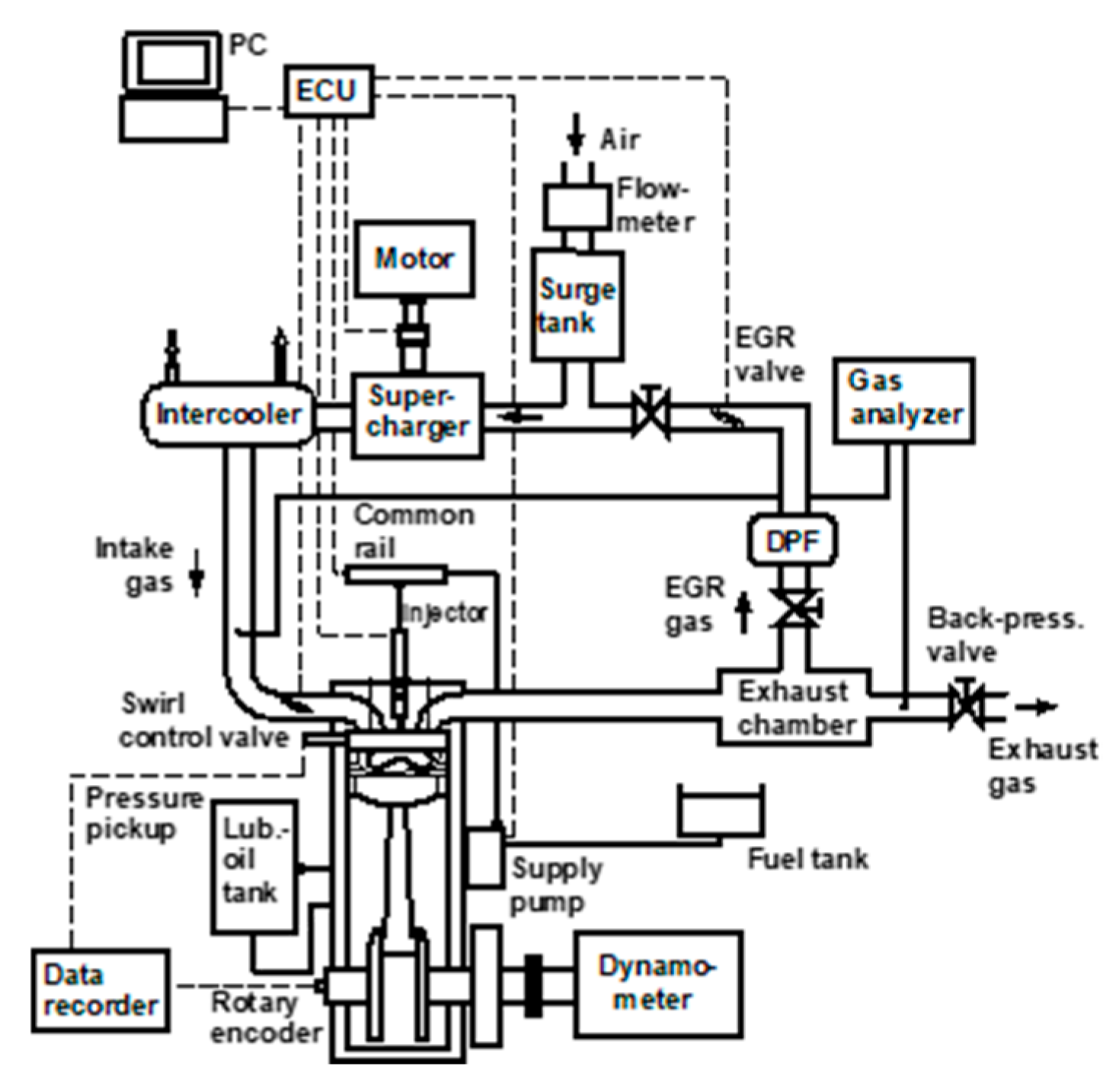

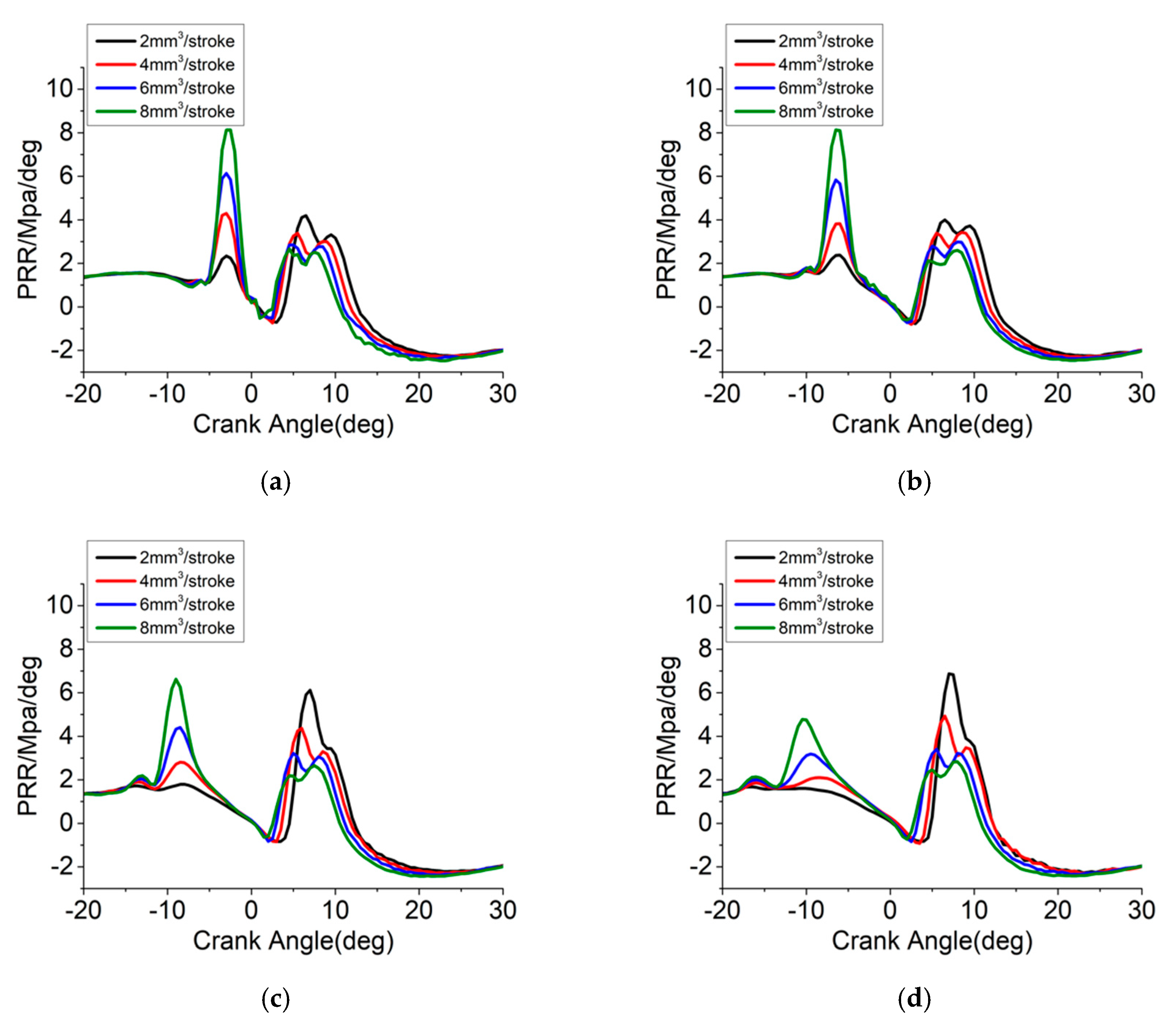
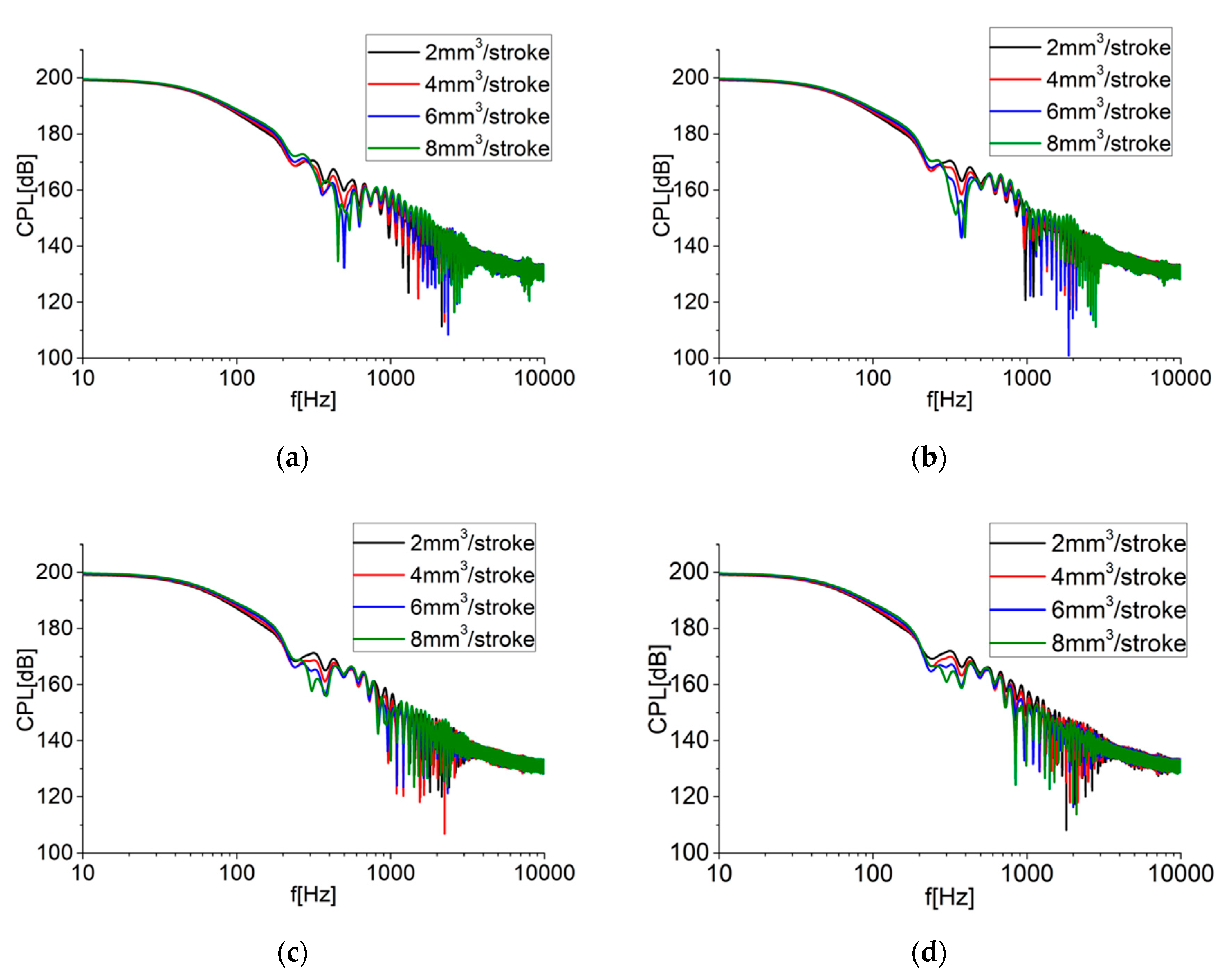
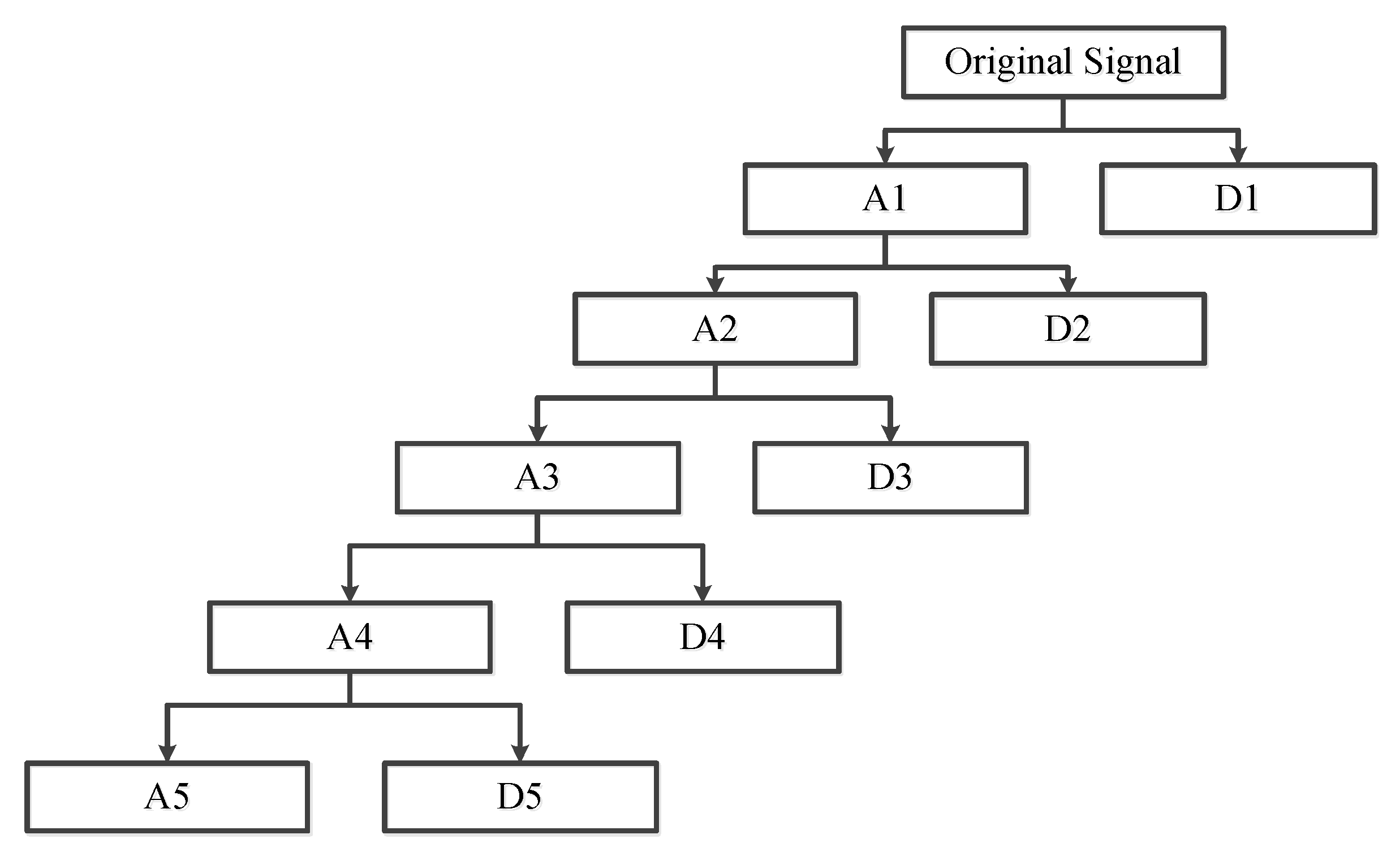
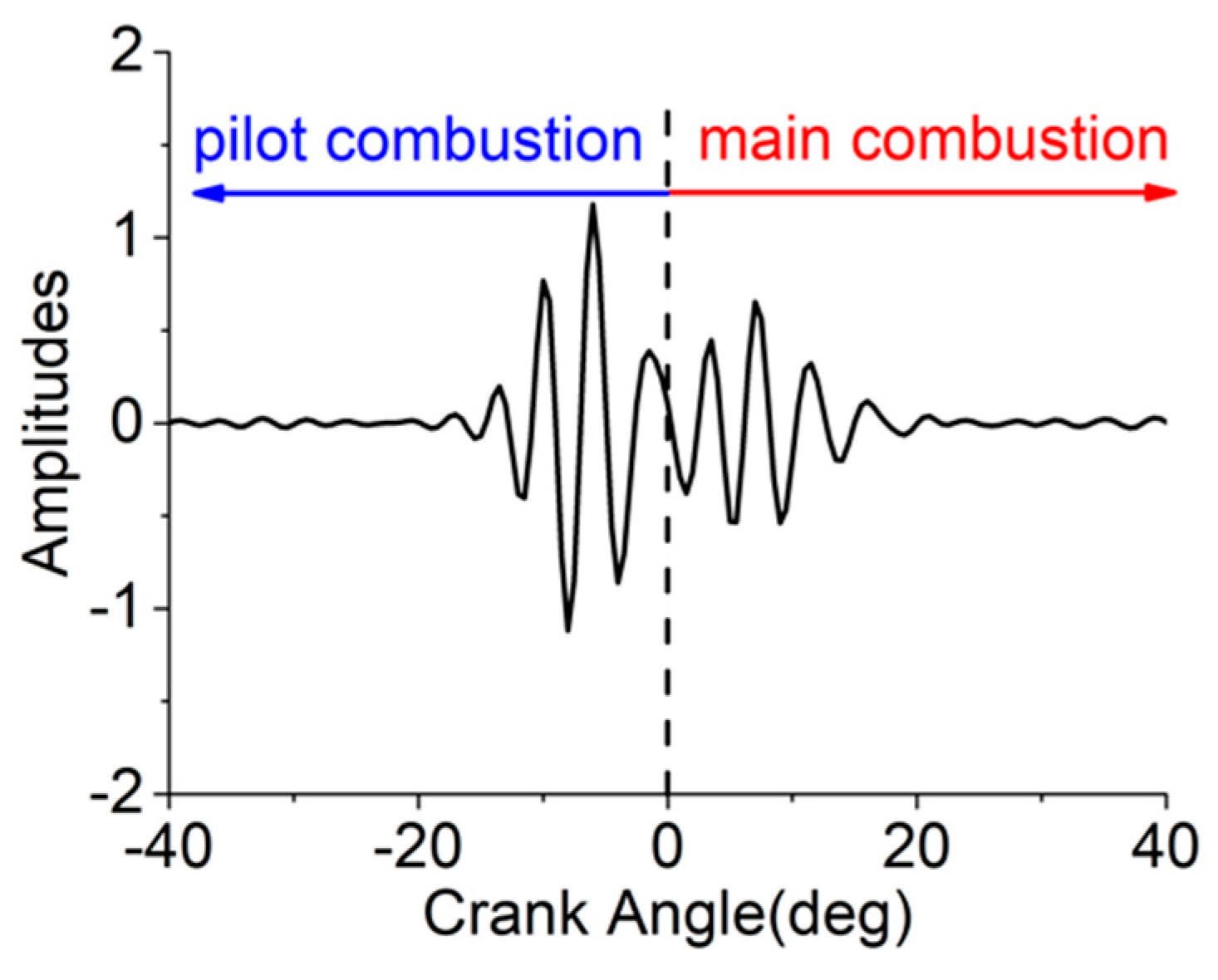

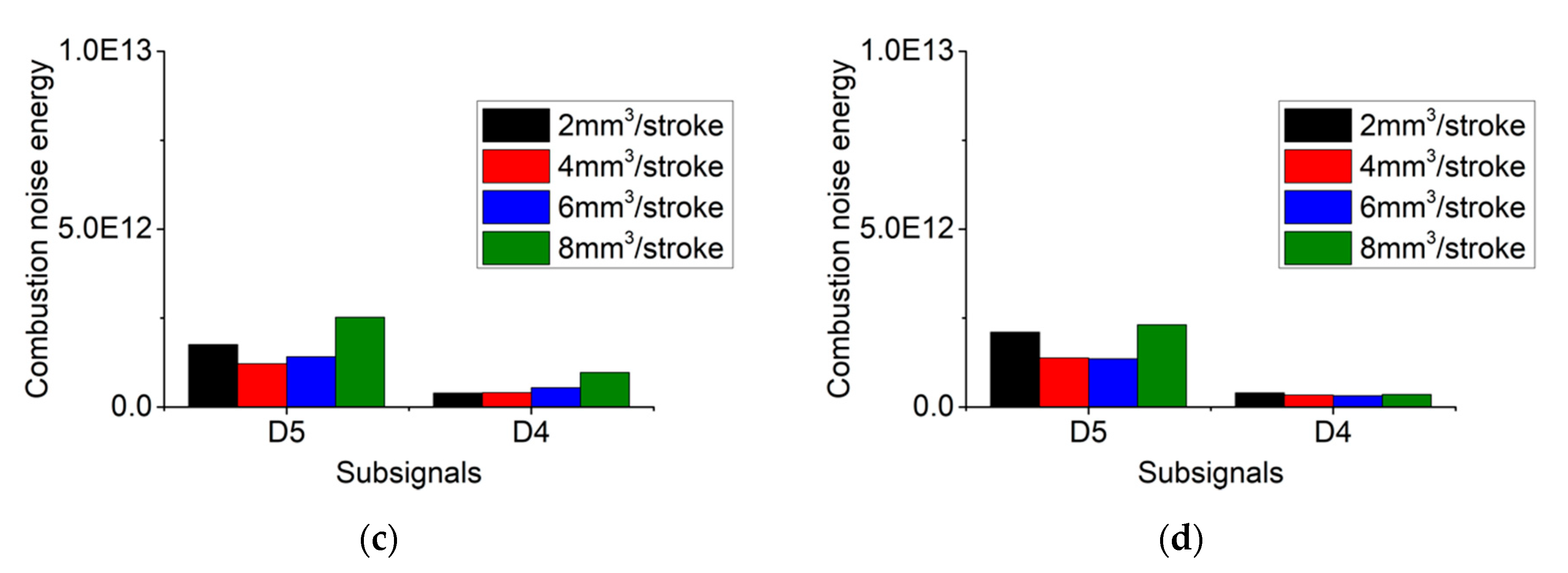
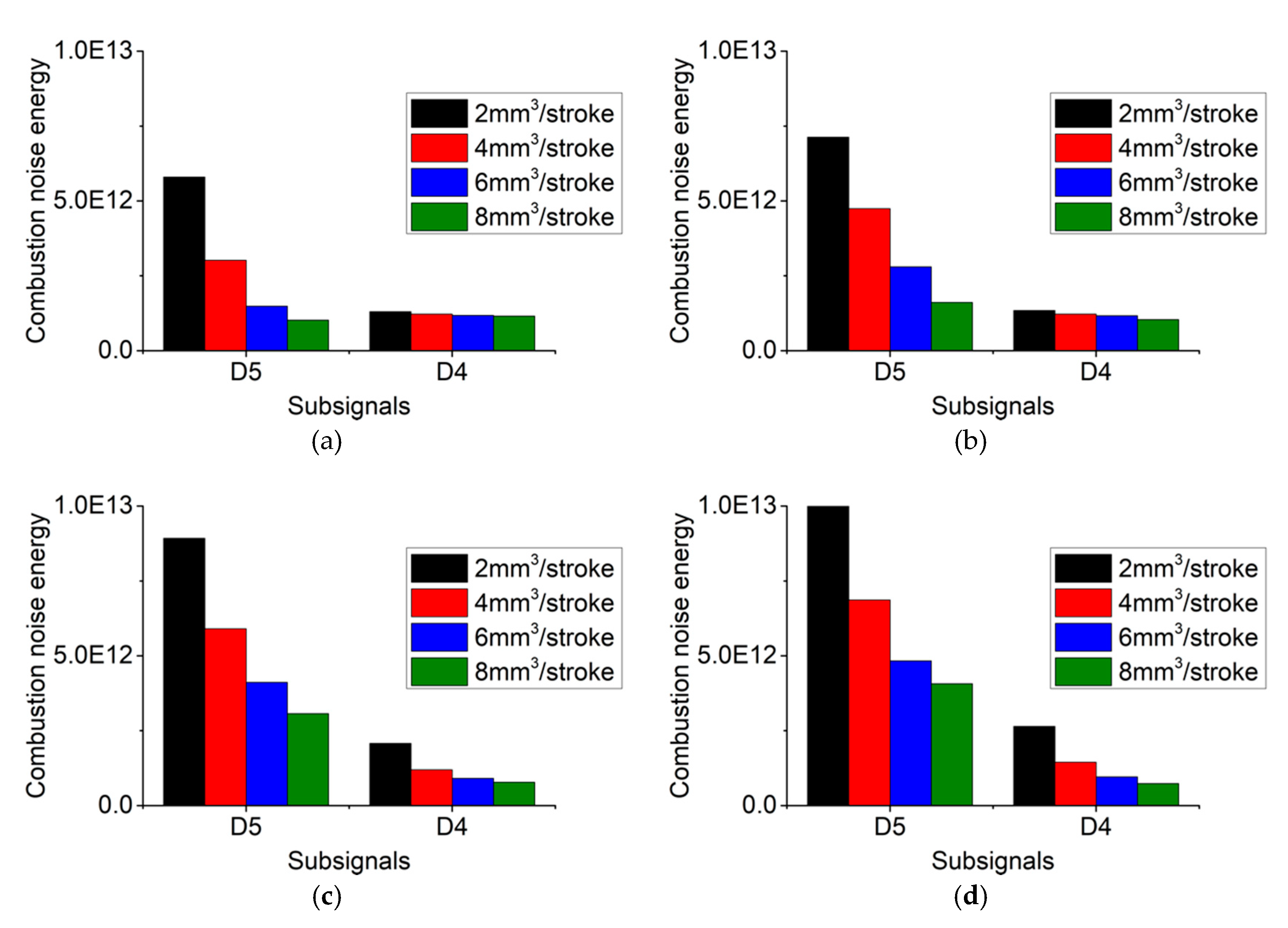
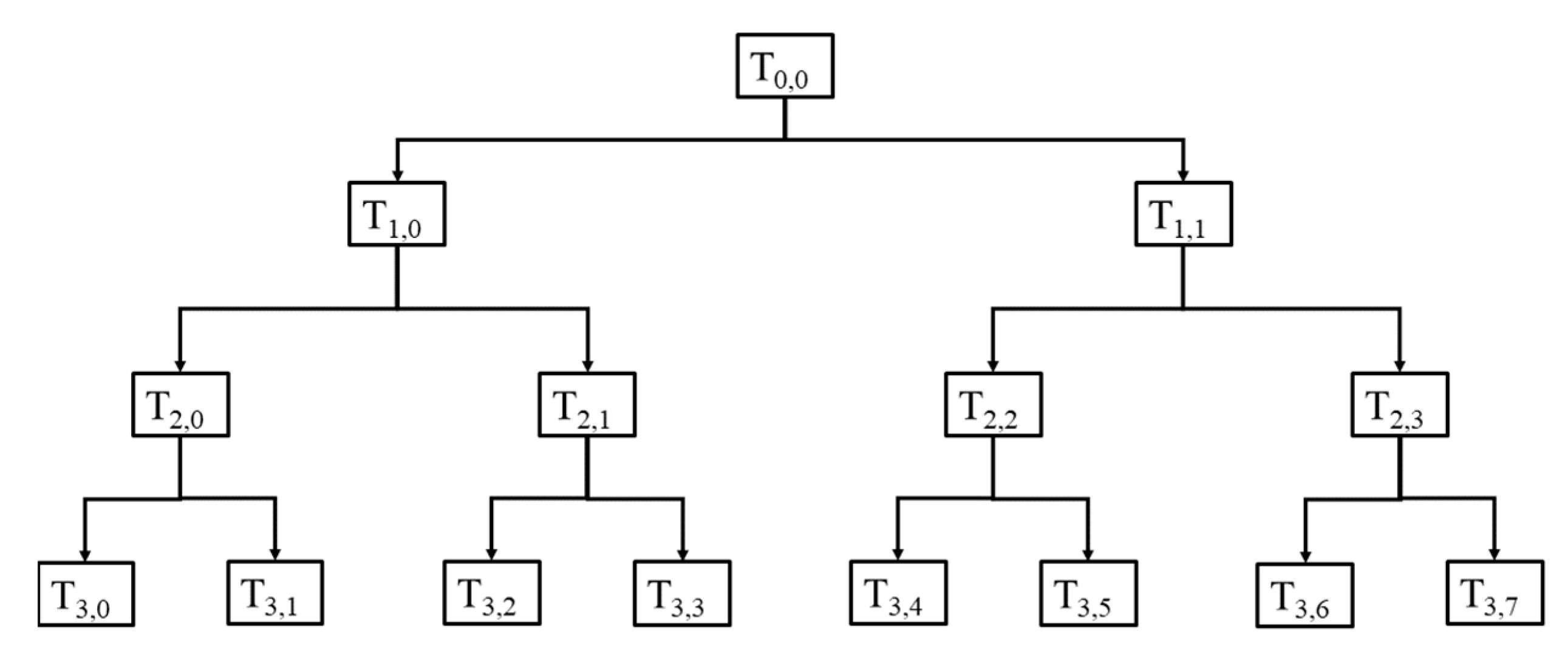
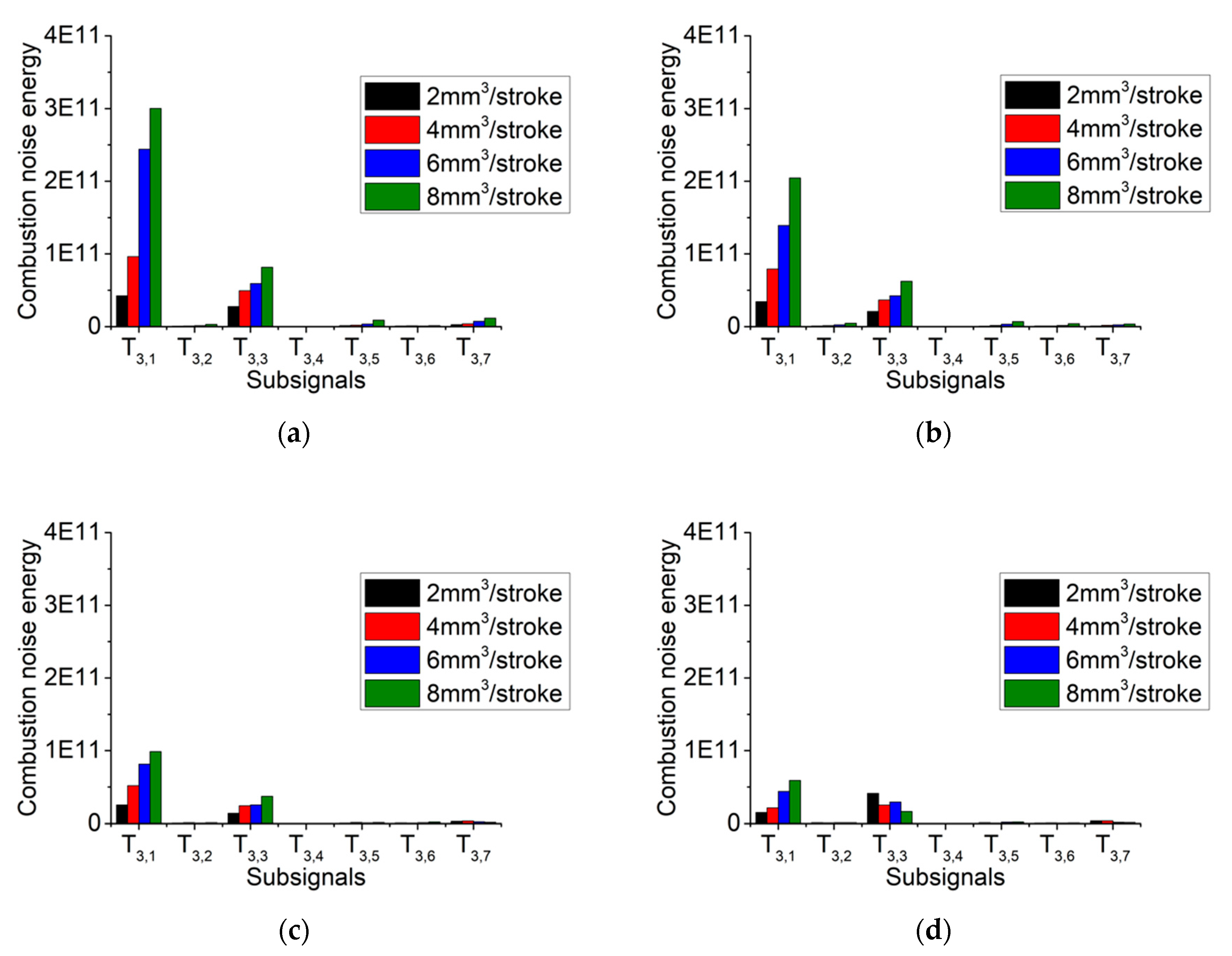
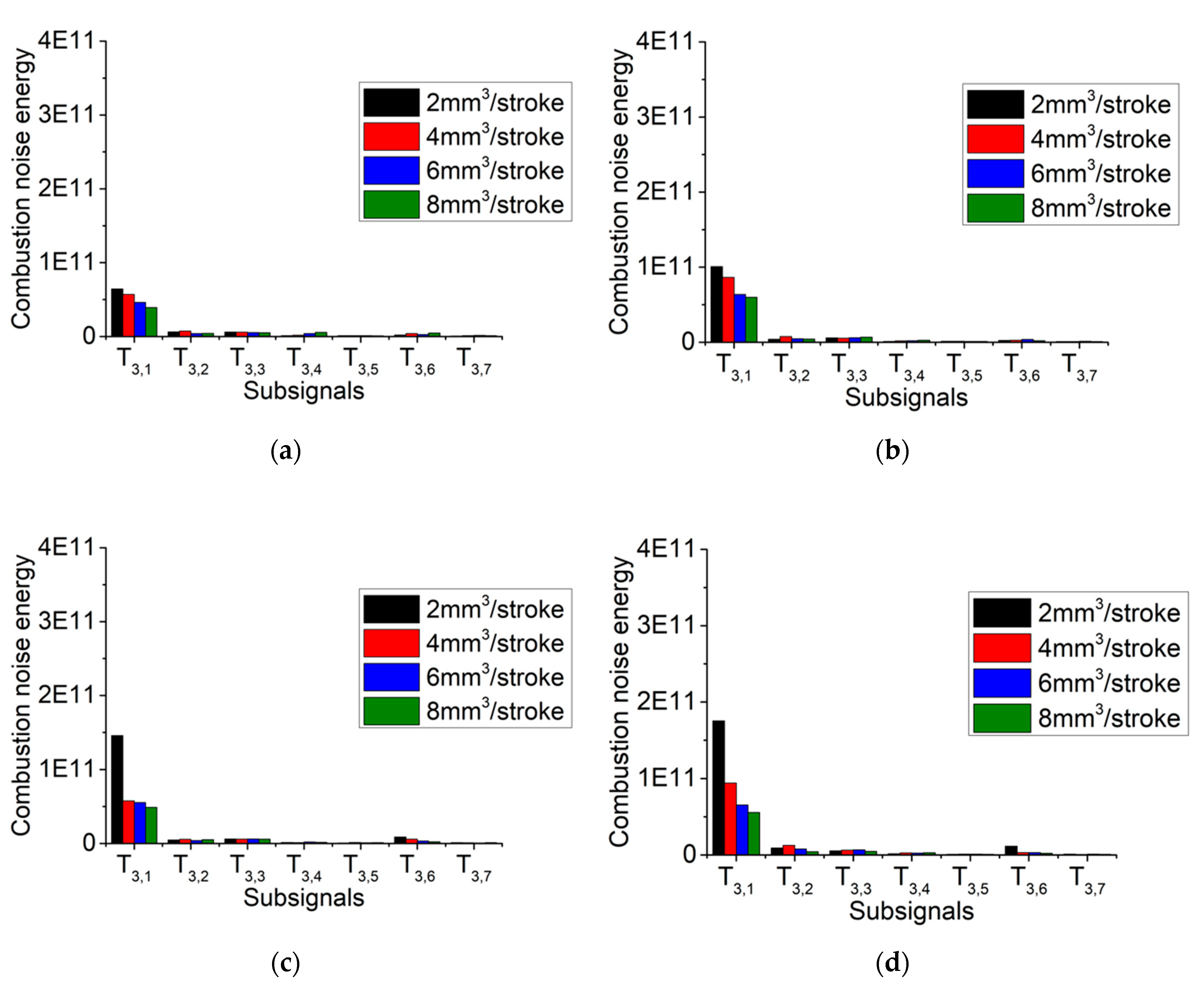

| Type | Single-Cylinder, Direct-Injection, Water-Cooled Diesel Engine |
|---|---|
| Bore × Stroke | 85 mm × 96.9 mm |
| Displacement | 550 cc |
| Compression ratio | 16.3 |
| Combustion chamber | Reentrant type (Cavity diameter: 51.6 mm) |
| Injection system | Common-rail system with a solenoid injector (Max. pressure: 180 MPa) 0.125 mm × 7 hole nozzle (Spray angle: 156°) |
| Supercharging | External supercharging |
| EGR system | Low-pressure loop EGR |
| Injection pressure | 125 MPa |
| Total injection quantity | 32 mm3/stroke |
| Pilot injection quantity (qpilot) | 2, 4, 6, 8 mm3/stroke |
| Pilot injection timing (θpilot) | −9, −14, −19, −24° ATDC |
| Main injection timing (θmain) | 1° ATDC |
| EGR rate | 20% |
| Swirl ratio | 2.0 |
| Sub-Signals | Frequency Band (Hz) |
|---|---|
| A5 | 0–281.25 |
| D5 | 281.25–562.5 |
| D4 | 562.5–1125 |
| D3 | 1125–2250 |
| D2 | 2250–4500 |
| D1 | 4500–9000 |
| Sub-Signals | Frequency Band (Hz) |
|---|---|
| T3,0 | 0–1125 |
| T3,1 | 1125–2250 |
| T3,2 | 2250–3375 |
| T3,3 | 3375–4500 |
| T3,4 | 4500–5625 |
| T3,5 | 5625–6750 |
| T3,6 | 6750–7875 |
| T3,7 | 7875–9000 |
© 2019 by the authors. Licensee MDPI, Basel, Switzerland. This article is an open access article distributed under the terms and conditions of the Creative Commons Attribution (CC BY) license (http://creativecommons.org/licenses/by/4.0/).
Share and Cite
Du, J.; Chen, X.; Liu, L.; Liu, D.; Ma, X. Mechanism of Combustion Noise Influenced by Pilot Injection in PPCI Diesel Engines. Appl. Sci. 2019, 9, 1875. https://doi.org/10.3390/app9091875
Du J, Chen X, Liu L, Liu D, Ma X. Mechanism of Combustion Noise Influenced by Pilot Injection in PPCI Diesel Engines. Applied Sciences. 2019; 9(9):1875. https://doi.org/10.3390/app9091875
Chicago/Turabian StyleDu, Jingtao, Ximing Chen, Long Liu, Dai Liu, and Xiuzhen Ma. 2019. "Mechanism of Combustion Noise Influenced by Pilot Injection in PPCI Diesel Engines" Applied Sciences 9, no. 9: 1875. https://doi.org/10.3390/app9091875
APA StyleDu, J., Chen, X., Liu, L., Liu, D., & Ma, X. (2019). Mechanism of Combustion Noise Influenced by Pilot Injection in PPCI Diesel Engines. Applied Sciences, 9(9), 1875. https://doi.org/10.3390/app9091875






